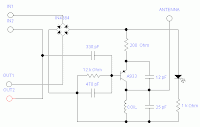About ATX Power Supply

ATX Power Supply converts the wall (AC) to the direct current (DC) needed by the
PC. The power supply looks like a metal box with fan.
Typical computer power supply generates the voltages needed by the computer motherboard accessories.
[Read more...]
Before Everything
Disconnect all socket from your main board, HDD, CD/DVD drive, Floppy drive and etc so that we can isolate which part
is not working.
Step 1 - Check Wall AC power

To check this, you may try to plug in any electrical appliances to the wall socket to verify that the 240V exist
such as lamp, table fan or etc. If it is working, that mean the power from the wall socket is ok.
You may also check the voltage with multimeter if you have one.
Step 2 - Power Socket Fuse

If you are using power socket with fuse, you may try to check this first.
The method is to plug the other end to other appliances such as your printer (turn on to verify),
monitor (turn on and look for LED indicator) or rice cooker (My rice cooker using the same type of socket).
Same thing, if it is ok, we know up to the power cord is also ok.
Step 3 - Voltage Selector

Not all power supply have this switch. My place using 240VAC.
So if it accidentally set to 110VAC the power supply maybe burn out. No more further troubleshooting.
But at place with 110VAC, maybe it will not burn out when it accidentally set to 240VAC.
It will in the low voltage condition and may not start I presume.
Select the correct voltage according to power provider rating.
Step 4 - 5V+ Standby Voltage
From bluemax.net


The first point that have voltage upon plug in the AC power is the standby voltage.[refer figure above]
5VSB constantly provides 5V power to the connector at pin 9.
Check this voltage using volt meter to make sure that 5V exist (while the AC is turn on).
Step 5 - Simulate Power On

Now is the interesting part. To turn on your ATX power supply without mother board, the way is to make contact
between pin 14 and ground pin(3,5,7,13,15,16,17). Meaning you can turn it on by connecting pin 14 with the only green wire
connecting to it to other ground pin that is the pin with black wire. To verify that the power supply is working,
the ventilation fan should be working split second after you connect pin 14 to ground. Paper clip would be the best choice.
Step 6 - Check All Output
Now you can check all voltage output from the power supply. You need a voltmeter in order to do that.
Pin |
Name |
|
Color |
Description |
|---|
1 |
3.3V |
|
Orange |
+3.3 VDC |
2 |
3.3V |
|
Orange |
+3.3 VDC |
3 |
COM |
|
Black |
Ground |
4 |
5V |
|
Red |
+5 VDC |
5 |
COM |
|
Black |
Ground |
6 |
5V |
|
Red |
+5 VDC |
7 |
COM |
|
Black |
Ground |
8 |
PWR_OK |
|
Gray |
Power Ok (+5V & +3.3V is ok) |
9 |
5VSB |
|
Purple |
+5 VDC Standby Voltage (max 10mA) |
10 |
12V |
|
Yellow |
+12 VDC |
11 |
3.3V |
|
Orange |
+3.3 VDC |
12 |
-12V |
|
Blue |
-12 VDC |
13 |
COM |
|
Black |
Ground |
14 |
/PS_ON |
|
Green |
Power Supply On (active low) |
15 |
COM |
|
Black |
Ground |
16 |
COM |
|
Black |
Ground |
17 |
COM |
|
Black |
Ground |
18 |
-5V |
|
White |
-5 VDC |
19 |
5V |
|
Red |
+5 VDC |
20 |
5V |
|
Red |
+5 VDC |
From bluemax.net
|

|
Good Luck

















































